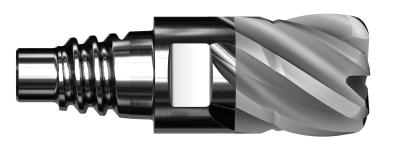
Sandvik Coromant is releasing two series of ceramic endmills for optimized performance in nickel-based alloys. The latest brazed ceramic CoroMill 316 and ceramic CoroMill Plura endmills offer a more productive method for roughing in ISO S materials compared to standard carbide milling cutters.
With aerospace components manufactured from nickel-based alloys becoming increasingly prevalent, the demand for optimized cutting tools is growing. With this in mind, Sandvik Coromant has developed two innovative solutions that are suitable for the shoulder and facemilling of nickel alloy aeroengine parts.
“The ceramic substrate of the latest CoroMill 316 and CoroMill Plura endmills allows for a different cutting process from traditional solid-carbide tools,” explains Tiziana Pro, global product manager for solid endmills at Sandvik Coromant. “Our unique CC6060 grade is purposefully-designed for the superior machining of nickel alloys and is supported by negative geometry that provides a tough cutting edge.”
The 6-flute geometry delivers highly productive side milling operations, while the 4-flute geometry boosts facemilling in both the CoroMill 316 and CoroMill Plura versions. The choice between the two depends on machine conditions and the application. Those seeking solutions for difficult-to-reach applications, or the extra flexibility of the exchangeable-head system, should opt for CoroMill 316, while those requiring superior stability are advised to select CoroMill Plura.
Ceramic tools retain their hardness at the high temperatures associated with milling heat -esistant superalloys (HRSAs). As a result, 20 to 30 times the speed can be achieved in comparison to solid-carbide tools, delivering considerable potential for increased productivity. A stable setup is advised without the use of coolant, as coolant would simply burn at this high temperature.
Beyond shoulder milling and facemilling, the new endmills can also be used for pocket milling, helical interpolation, ramping and slot milling. Both CoroMill Plura and CoroMill 316 are part of the Sandvik Coromant Optimized solutions offer within the company’s solid round tools range.
The newly introduced series also includes a ceramic ballnose version of CoroMill 316 for blisk machining. This profile-milling solution is suitable for semifinishing operations.
Contact Details
Related Glossary Terms
- alloys
alloys
Substances having metallic properties and being composed of two or more chemical elements of which at least one is a metal.
- coolant
coolant
Fluid that reduces temperature buildup at the tool/workpiece interface during machining. Normally takes the form of a liquid such as soluble or chemical mixtures (semisynthetic, synthetic) but can be pressurized air or other gas. Because of water’s ability to absorb great quantities of heat, it is widely used as a coolant and vehicle for various cutting compounds, with the water-to-compound ratio varying with the machining task. See cutting fluid; semisynthetic cutting fluid; soluble-oil cutting fluid; synthetic cutting fluid.
- facemilling
facemilling
Form of milling that produces a flat surface generally at right angles to the rotating axis of a cutter having teeth or inserts both on its periphery and on its end face.
- gang cutting ( milling)
gang cutting ( milling)
Machining with several cutters mounted on a single arbor, generally for simultaneous cutting.
- hardness
hardness
Hardness is a measure of the resistance of a material to surface indentation or abrasion. There is no absolute scale for hardness. In order to express hardness quantitatively, each type of test has its own scale, which defines hardness. Indentation hardness obtained through static methods is measured by Brinell, Rockwell, Vickers and Knoop tests. Hardness without indentation is measured by a dynamic method, known as the Scleroscope test.
- interpolation
interpolation
Process of generating a sufficient number of positioning commands for the servomotors driving the machine tool so the path of the tool closely approximates the ideal path. See CNC, computer numerical control; NC, numerical control.
- milling
milling
Machining operation in which metal or other material is removed by applying power to a rotating cutter. In vertical milling, the cutting tool is mounted vertically on the spindle. In horizontal milling, the cutting tool is mounted horizontally, either directly on the spindle or on an arbor. Horizontal milling is further broken down into conventional milling, where the cutter rotates opposite the direction of feed, or “up” into the workpiece; and climb milling, where the cutter rotates in the direction of feed, or “down” into the workpiece. Milling operations include plane or surface milling, endmilling, facemilling, angle milling, form milling and profiling.
- superalloys
superalloys
Tough, difficult-to-machine alloys; includes Hastelloy, Inconel and Monel. Many are nickel-base metals.

